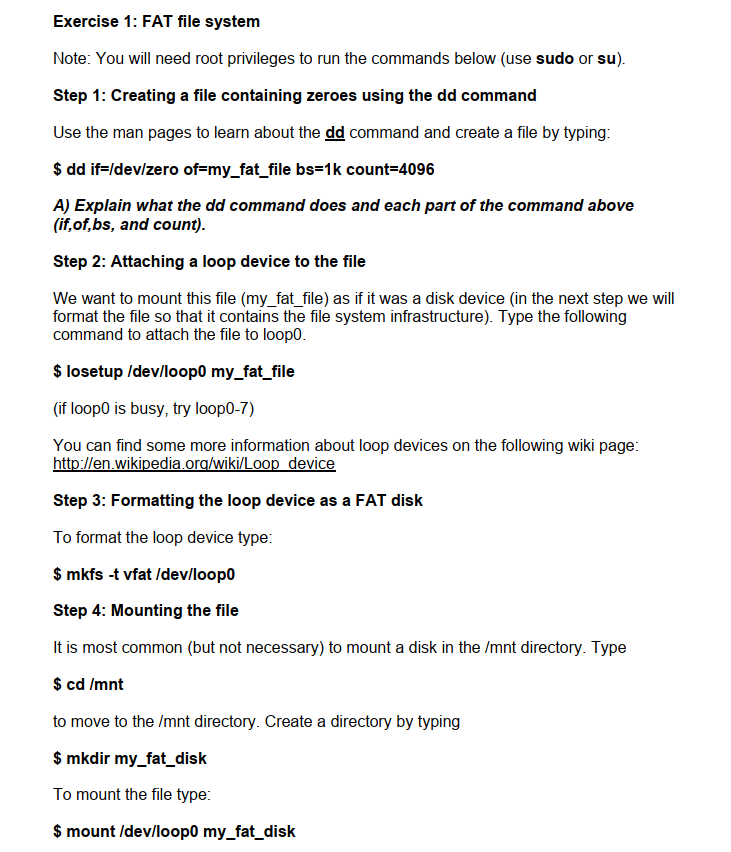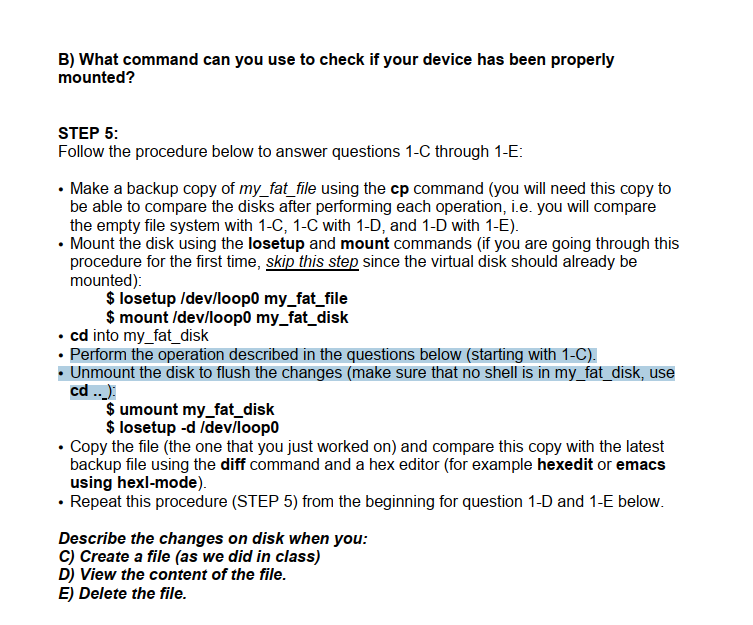Answered step by step
Verified Expert Solution
Question
1 Approved Answer
Examine the FAT file system by performing some common operations such as create, delete, and modify a file. learn how NTFS compares with the FAT
Examine the FAT file system by performing some common operations such as create, delete, and modify a file. learn how NTFS compares with the FAT file system with respect to complexity.


It requires work on Linux, it can be worked on Ubuntu on VMWare.
That's all of information that I have.
Thank you
Exercise 1: FAT file system Note: You will need root privileges to run the commands below (use sudo or su). Step 1: Creating a file containing zeroes using the dd command Use the man pages to learn about the dd command and create a file by typing: $ dd if=/dev/zero of=my_fat_file bs=1k count=4096 A) Explain what the dd command does and each part of the command above (if,of, bs, and count). Step 2: Attaching a loop device to the file We want to mount this file (my_fat_file) as if it was a disk device in the next step we will format the file so that it contains the file system infrastructure). Type the following command to attach the file to loop. $ losetup /dev/loop my_fat_file (if loop is busy, try loop0-7) You can find some more information about loop devices on the following wiki page: http://en.wikipedia.org/wiki/Loop device Step 3: Formatting the loop device as a FAT disk To format the loop device type: $ mkfs -t vfat /dev/loop Step 4: Mounting the file It is most common (but not necessary) to mount a disk in the /mnt directory. Type $ cd /mnt to move to the /mnt directory. Create a directory by typing $ mkdir my_fat_disk To mount the file type: $ mount /dev/loop my_fat_disk B) What command can you use to check if your device has been properly mounted? STEP 5: Follow the procedure below to answer questions 1-C through 1-E: Make a backup copy of my_fat_file using the cp command (you will need this copy to be able to compare the disks after performing each operation, i.e. you will compare the empty file system with 1-C, 1-C with 1-D, and 1-D with 1-E). Mount the disk using the losetup and mount commands (if you are going through this procedure for the first time, skip this step since the virtual disk should already be mounted): $ losetup /dev/loop my_fat_file $ mount /dev/loop my_fat_disk cd into my_fat_disk Perform the operation described in the questions below (starting with 1-C). Unmount the disk to flush the changes (make sure that no shell is in my_fat_disk, use cd ...): $ umount my_fat_disk $ losetup -d /dev/loopo Copy the file (the one that you just worked on) and compare this copy with the latest backup file using the diff command and a hex editor (for example hexedit or emacs using hexl-mode). Repeat this procedure (STEP 5) from the beginning for question 1-D and 1-E below. Describe the changes on disk when you: C) Create a file (as we did in class) D) View the content of the file. E) Delete the file. Exercise 1: FAT file system Note: You will need root privileges to run the commands below (use sudo or su). Step 1: Creating a file containing zeroes using the dd command Use the man pages to learn about the dd command and create a file by typing: $ dd if=/dev/zero of=my_fat_file bs=1k count=4096 A) Explain what the dd command does and each part of the command above (if,of, bs, and count). Step 2: Attaching a loop device to the file We want to mount this file (my_fat_file) as if it was a disk device in the next step we will format the file so that it contains the file system infrastructure). Type the following command to attach the file to loop. $ losetup /dev/loop my_fat_file (if loop is busy, try loop0-7) You can find some more information about loop devices on the following wiki page: http://en.wikipedia.org/wiki/Loop device Step 3: Formatting the loop device as a FAT disk To format the loop device type: $ mkfs -t vfat /dev/loop Step 4: Mounting the file It is most common (but not necessary) to mount a disk in the /mnt directory. Type $ cd /mnt to move to the /mnt directory. Create a directory by typing $ mkdir my_fat_disk To mount the file type: $ mount /dev/loop my_fat_disk B) What command can you use to check if your device has been properly mounted? STEP 5: Follow the procedure below to answer questions 1-C through 1-E: Make a backup copy of my_fat_file using the cp command (you will need this copy to be able to compare the disks after performing each operation, i.e. you will compare the empty file system with 1-C, 1-C with 1-D, and 1-D with 1-E). Mount the disk using the losetup and mount commands (if you are going through this procedure for the first time, skip this step since the virtual disk should already be mounted): $ losetup /dev/loop my_fat_file $ mount /dev/loop my_fat_disk cd into my_fat_disk Perform the operation described in the questions below (starting with 1-C). Unmount the disk to flush the changes (make sure that no shell is in my_fat_disk, use cd ...): $ umount my_fat_disk $ losetup -d /dev/loopo Copy the file (the one that you just worked on) and compare this copy with the latest backup file using the diff command and a hex editor (for example hexedit or emacs using hexl-mode). Repeat this procedure (STEP 5) from the beginning for question 1-D and 1-E below. Describe the changes on disk when you: C) Create a file (as we did in class) D) View the content of the file. E) Delete the fileStep by Step Solution
There are 3 Steps involved in it
Step: 1

Get Instant Access to Expert-Tailored Solutions
See step-by-step solutions with expert insights and AI powered tools for academic success
Step: 2

Step: 3

Ace Your Homework with AI
Get the answers you need in no time with our AI-driven, step-by-step assistance
Get Started


